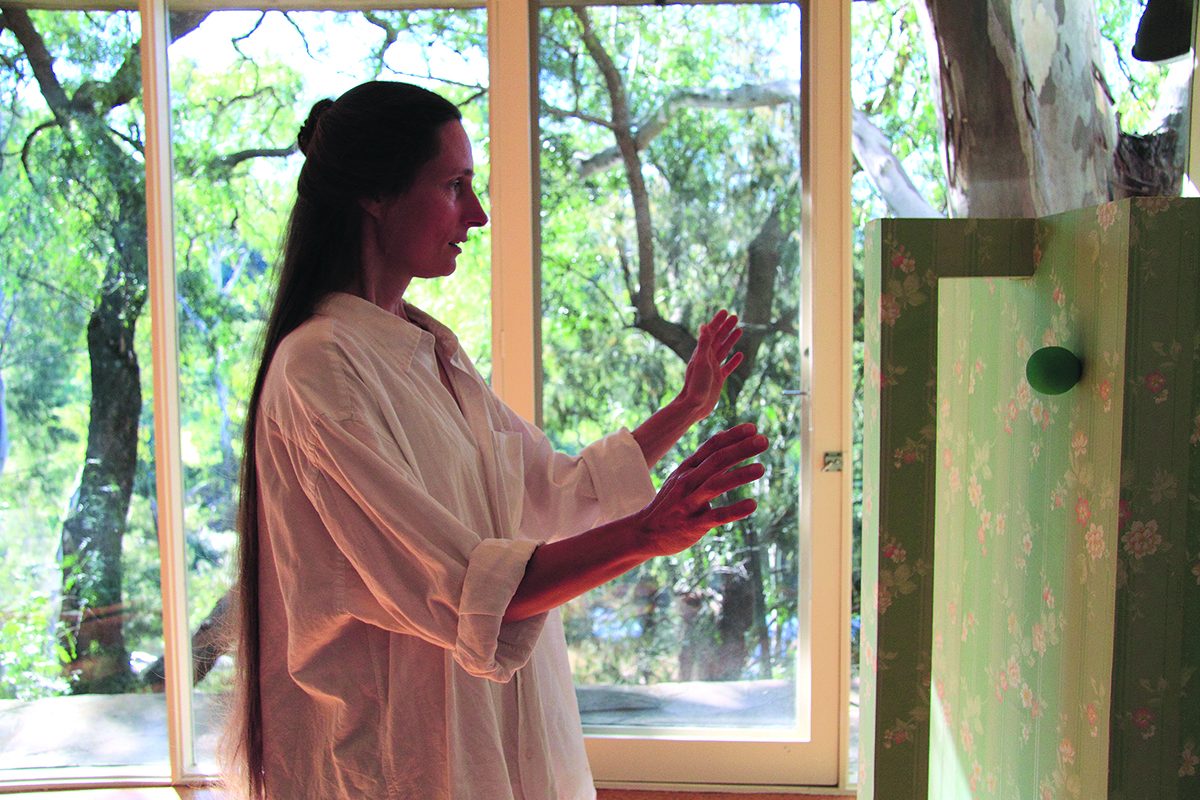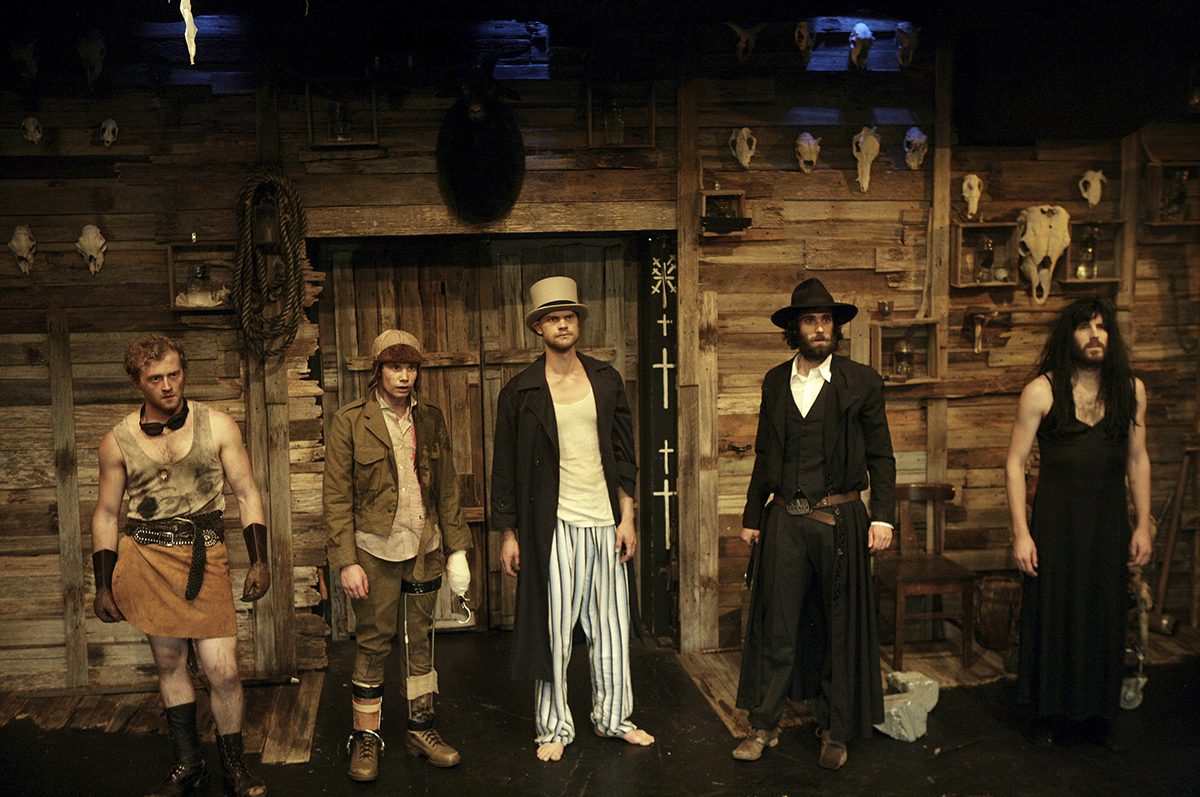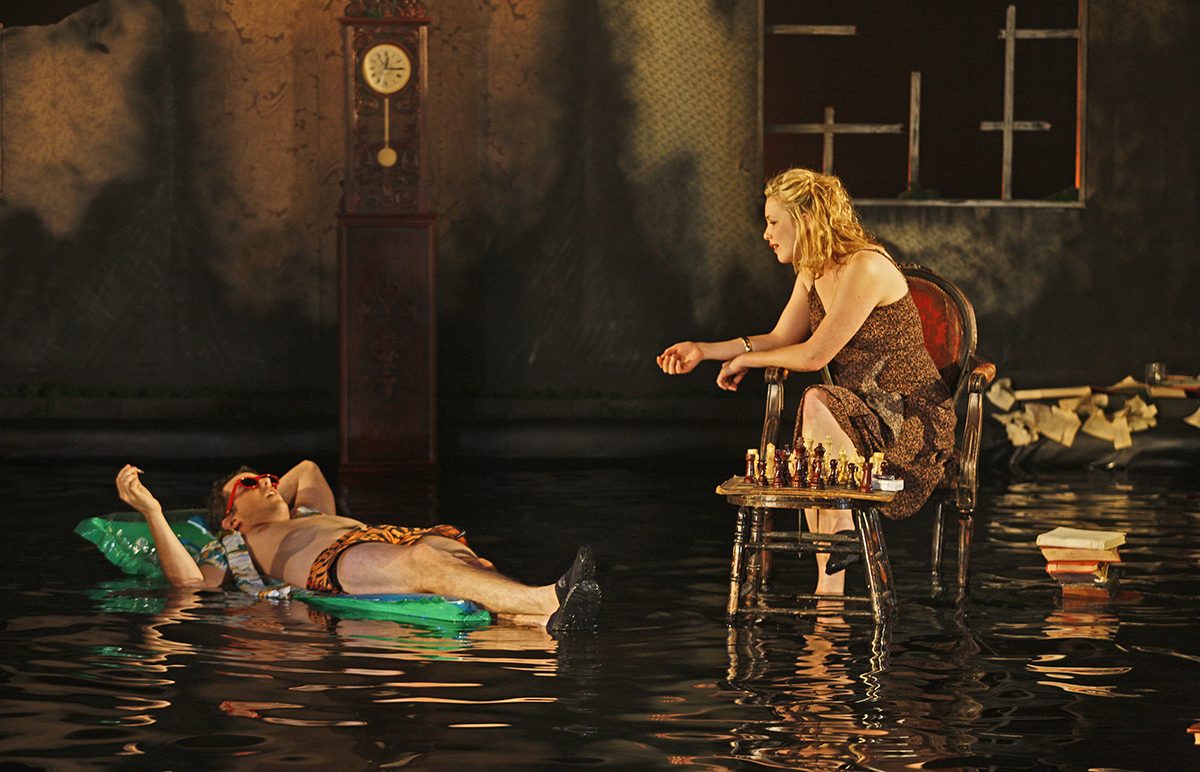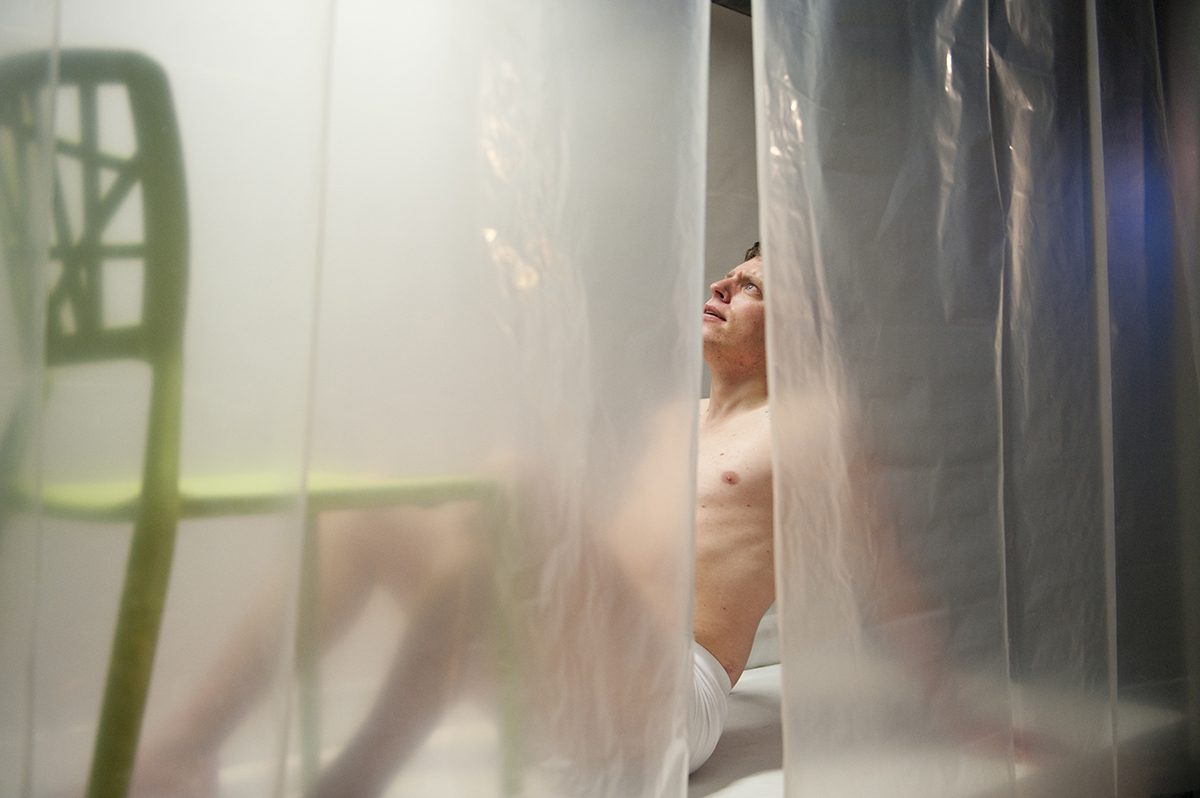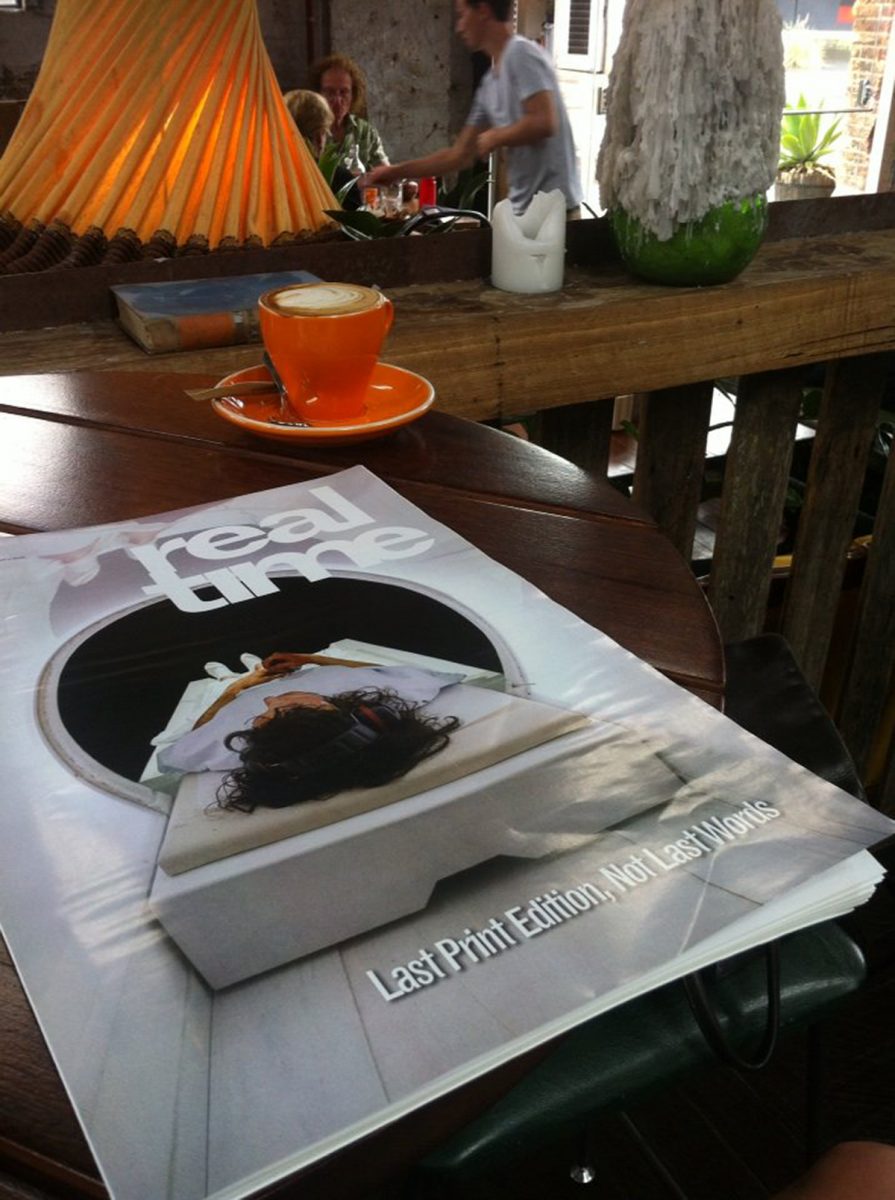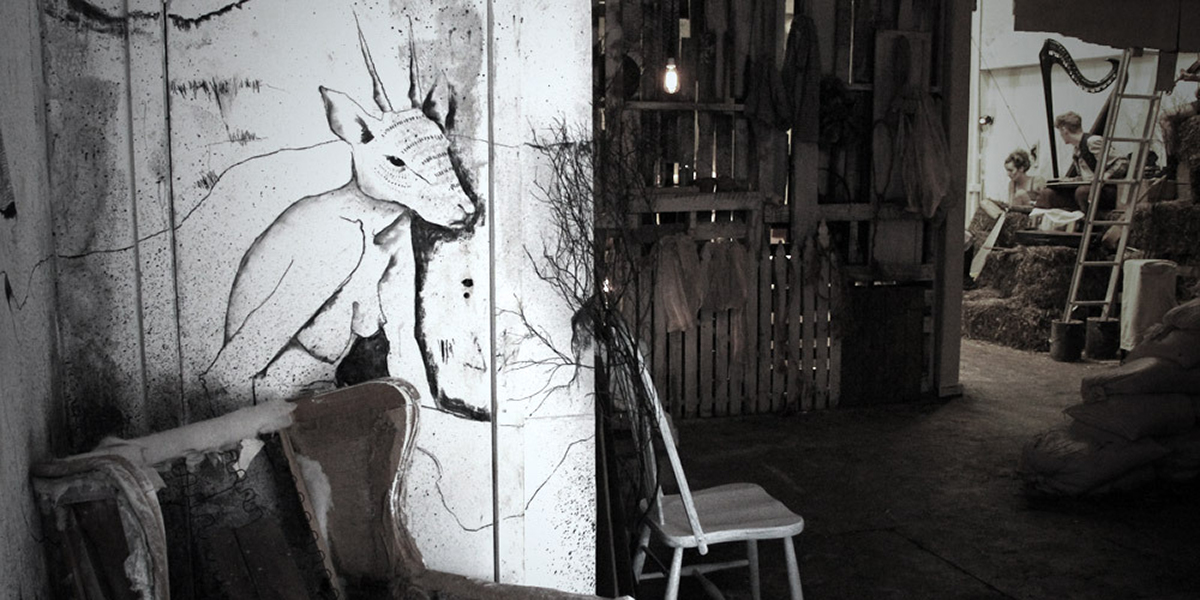
Scene changes: Mapping Melbourne theatre 2005-2015
The way across the bluestone cobbles was lit with dozens of flickering tea candles. A man stood at the corner of Clarke Street and Little Bakers Lane in Northcote, holding a lantern. Bicycles were chained haphazardly to street signs and old gas pipes jutting at crazy angles into the narrow laneway. Shadowy figures and groups of figures, hunched against the cold of the night, made their way toward a small door in a plain redbrick wall.
It was the sort of door that brings to mind the small entrance that Herman Hesse’s Harry Haller notices one cold and wet evening in a dark lane—the door to a secret world:
MAGIC THEATRE
ENTRANCE NOT FOR EVERYBODY
And truly this was a kind of magic theatre. The show was Orpheus, presented by junkyard minstrels the Four Larks in July of 2010 in a warehouse in Northcote. This little opera was spectacular, an enchantment of music and poetry and immersive design; but, really, the event began long before we passed through that unremarkable door. Advertisements for the show described the venue as a secret location in Northcote. The operation of getting to the show, and the excitement of not knowing exactly what we would find, was all part of what made the evening so theatrically interesting and so memorable. The emotional experience of the play blended—and was an extension of—the experience of navigating the city.
Every city contains a multitude of cities. There are subcultures within subcultures. Social scenes stacked within social scenes. And every level has its own particular urban vision. As Rebecca Solnit says, there are infinite ways of mapping a city. You discover a new scene and you enter a new city, one with its own landmarks and its own centres, its own thoroughfares and desire lines, and its own wastelands.
The word “scene,” of course, has negative connotations. The scene is where the scenesters want to be. It’s where the fashionable and the hip congregate. The scene is a place to be seen. But it can also denote, more simply, a shared sense of place based on common interests. We often hear about the performing arts community, but for me it was a scene in this psychogeographical sense before it was a community. It was a particular image of the city: the scene as a place where a particular activity occurs.
In the early 2000s I was fascinated by and deeply invested in Melbourne’s live music scene. Or, to be more specific, Melbourne’s indie rock scene. The landmarks that orientated my experience of the city were places like the Tote, the Empress of India, Good Morning Captain, Arthouse, the Punters Club, the Corner Hotel, the Rob Roy, the Town Hall Hotel and perhaps a dozen or so other regular haunts. Some of them are gone, some are unrecognisable and some are still powering on the same as before.
I had a map of the city that I shared with—or partially shared with—hundreds or perhaps thousands of others who were into making or listening to the same kind of music. The scene was navigated by word-of-mouth, of course, but also email lists, community radio and street press. That was how I mapped the city, quantified it, orientated myself and aligned with others.
Although it was—and probably still is—a uniquely vibrant scene, by the mid-2000s I was losing my passion for the music. My enthusiasm shifted toward theatre and performance art. The door to a new city opened. My collection of mental maps rapidly altered. There were new backdrops and new feelings about both unfamiliar and familiar parts of Melbourne. As a way of extending my knowledge of this new scene I turned to RealTime. I recognised it as the performing arts equivalent of the free rock music-focused street press. It had the same tabloid format and glossy full-colour cover. And like those music magazines —Inpress and Beat were the dominant mastheads at that time—its physical presence on the streets meant something. A bundle of RealTime in the foyer or near the bar or by the door was like a newsprint trail marker, signalling that this venue was a significant location, that it was part of the scene.
For me, however, what was really exciting about the live performance scene in the second half of the 2000s was the amount of work being made outside of those venues.
There were shows in private homes—in garages and lounge rooms and backyards. Some of these were, essentially, site-specific, engaging with the semiotics of domesticity and reflecting on themes of homeliness. Others, however, treated the home as just another empty space in which any sort of drama might be imagined. Those were the ones that really thrilled; there was a scrappy do-it-yourself ethos I recognised from the live music scene. There were shows by groups like the Melbourne Town Players, Four Larks, Sisters Grimm and I’m Trying to Kiss You. In 2010, stalwart experimentalists Chamber Made Opera, under artistic director David Young, even launched a critically successful series of performances staged in private living rooms around the city.
Many of these events were programmed as part of city-wide festivals like Next Wave or the Melbourne Fringe or, more recently, the Festival of Live Art, umbrella events that aim to transform the city by supporting venues in new and unexpected locations. These festivals with their sprawling programs undoubtedly help shift ideas about where the performing arts belong; but what really excited me in the second half of the 2000s and the early part of the 2010s was the independent DIY attitude of performance makers who created new venues without festival support.
There was Black Lung, who opened a theatre above Kent Street Bar in Fitzroy. (They also created a temporary venue under the Hindley Street ice rink for the 2007 Adelaide Fringe.)
The Hayloft Project lavishly did up a theatre space in Footscray for their Chekhov Re-Cut: Platonov. The Sisters Grimm built a theatre in the Collingwood Underground Carpark for their productions of Cellblock Booty and Little Mercy. Mutation Theatre briefly worked out of a space above a café on Smith Street. And the entrepreneurial MKA colonised multiple spaces across Melbourne with their pop-theatres. And then, of course, there was Four Larks, who transformed warehouse spaces in Richmond, Northcote and Brunswick.
I won’t claim that Melbourne’s independent theatre makers are or were any more adventurous or pioneering than independent theatre makers in other cities, but there was something about seeing vacant urban spaces not simply reanimated for a one-off site-specific event but, in some important way, reclaimed in a way that felt specifically Melbourne. It was like we—the audience and the theatre maker—were participating directly in the mythology of the city’s theatre past. As I wrote in 2016:
“For anyone who first started seeing independent theatre in Melbourne in the mid 2000s, the names Daniel Keene and Ariette Taylor loomed large. Even half a decade after their last collaboration, people were still talking. The Keene/Taylor Theatre Project, a small ensemble established in 1997, was the default comparison for those who knew. It was a template for what independent theatre should feel like, the aura it should create: audiences thrilled by the discovery of a hidden artistic world outside the usual institutions. It gave us, the ones who weren’t there, something to look for, a feeling intimate and direct.
“And when we made our own discoveries—in warehouses in Northcote, above bars on Smith Street, or wherever—what we felt was not only a sense of excitement and community but, too, a sense of continuity with the past. The scene was larger and more alive and more significant for the recognition. It felt more like a real culture.”
And so, a tradition can be traced from Black Lung or Hayloft or Four Larks back through the Keene/Taylor Theatre Project to Gilgul and their shows at Town Hall Motors, then back further to the Pram Factory and then to the little theatre scene of the 1940s and 1950s. The do-it-your-self ethos is not an exclusively Melbourne phenomenon, but it is a major part of the story we tell of the performing arts in this city.
Of course, the independent performing arts scene in the decade 2005 to 2015, like every scene, had its centres and therefore its peripheries. For me and many others, the centre was undoubtedly the inner city and northern suburbs. Unless it was for the Big West Festival or Next Wave, I rarely crossed the Maribyrnong. There were a couple of exceptions, however. Peta Hanrahan’s Dog Theatre in Footscray was launched in 2008 with an ambitious series of short Daniel Keene plays directed by Matt Scholten. And 2008 also saw the opening of The Substation in Newport. Similarly, Melbourne’s east was a bit of a dead zone, though MKA tried (very briefly), as did the Owl and the Pussy Cat, also in Richmond.
What I remember is forever travelling north to south, south to north. Today, the idea of pedalling from Brunswick to Prahan or St Kilda for a theatre show seems absurd; and yet in those days I did it regularly. I imagine those north-south routes as corridors lined with archive boxes where—in bedrooms, galleries, basements, foyers, nooks, chambers, belfries, halls, loungerooms, garages—a collection of memories is stored.
There was one particular Mutations Theatre show called Habitat in a room the company was using for a while above a café on Smith Street. It was a small talky sort of show in the Ranters Theatre mould. What I remember most clearly now, however, is the moment at the end, after the talking stopped, when James Tresise opened the sash window of the small room overlooking Smith Street. Opening the theatre to the outside world is an old device but it can be effective. A theatre must provide a kind of frame and must, in a sense, be a closed-off territory; but there also needs to be some way of letting in the great muddle of the world, with its bustle and noise. It was March and it was warm and still bright outside. A tram rumbled past. The roar of the street filled the room, connecting with the reality of the play. The habitat of the theatre was for a moment infinitely expanded.
During this time, in the decade between 2005 and 2015, social media decisively replaced print media as the key channel through which audiences learned about new shows and shared their experiences. And one thing these companies—Hayloft, MKA, Black Lung and Four Larks—shared above all was social media savvy. The buzz they generated was palpable. I remember, for example, the absurd hype around Glassoon, one of Black Lung’s last shows in Melbourne. It was impossible to find a substantial review of the production; but everyone was talking about the afterparty. I also remember the speed with which Four Larks, advertising on Facebook, would sell out their seasons. At one of their sold-out performances of The Temptation of Saint Anthony in the old Body Corp garage in Brunswick, one disappointed punter watched the whole show from the laneway, peering through a gap under the door.
The shift toward online marketing and reviewing was of course a small part of larger tectonic upheavals in the media landscape. Those upheavals eventually led to the end of RealTime’s print editions in 2015. The magazine carried on for a few years as a digital masthead, but it was no longer a street press paper and that meant something. It wasn’t just the look and feel of the magazine that changed; the nature of its connection with the performing arts scene also changed.
In any case, by 2015 the scene was not what it had been. That was the year of the final Neon Festival of Independent Theatre at the Melbourne Theatre Company, which, in retrospect, marked the end of a particular attitude to making theatre in Melbourne. As I later wrote in an article for RealTime:
“Looking back, I think the signal moment was probably the Melbourne Theatre Company’s three Neon seasons (2013-2015). Billed as a festival of independent theatre, this short-lived program in fact announced the end of independent theatre. It was an acknowledgement that separateness from large cultural institutions was no longer regarded by theatre makers as something in itself desirable. It was no longer us and them. The Neon Festival was the dream of a single integrated performing arts ecology with clear career pathways from the fringe to the centre, gleaming like emerald-coloured bike lanes.”
A theatre culture that had not only worked in the fringes but revelled in them, one that had created its own public spaces and demanded attention, had at last been recouped by the subsidised establishment and placed back into the official or designated space of the arts precinct. Whether or not that’s a fair assessment, it is nonetheless true that there are currently very few theatre makers taking control of the apparatus and building their own temporary venues.
And yet – there are always exceptions. That punter in the laneway at the Four Larks show is now making her own work with her own group which is, if possible, even more radically committed to independence than the Larks were. And so the tradition continues, quietly, secretively.
–
Commissioned by RealTime, this essay will form part of an upcoming book by Jana Perkovic and Andrew Fuhrmann critically documenting the period 2005-2015 in Melbourne theatre and performance.
Read about Andrew Fuhrmann here.
Top image credit: Peer Gynt, Four Larks, 2010 photo Stephanie Butterworth & Zoe Spawton


